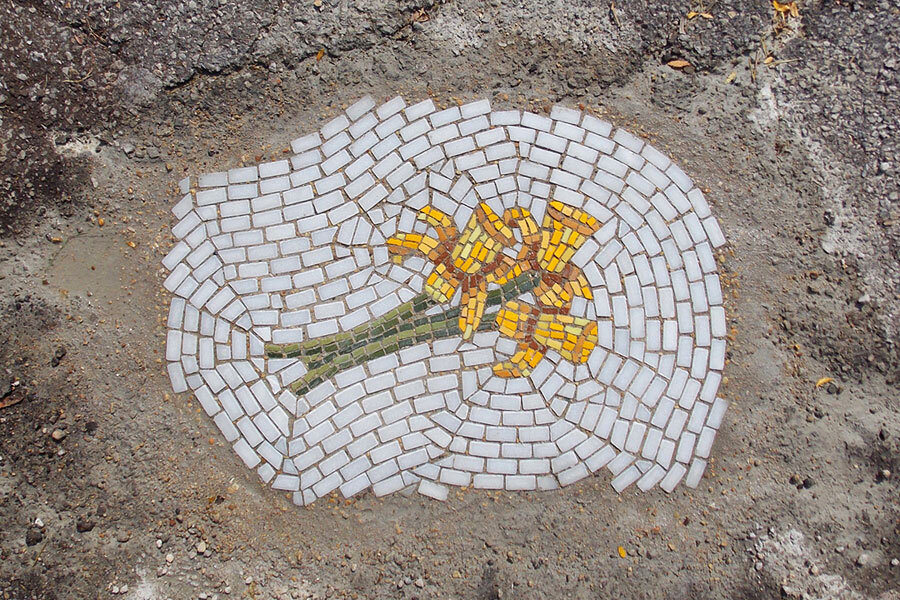How a guerilla artist is transforming Chicago's potholes
Loading...
Illinois artist Jim Bachor never avoids a Chicago pothole because he sees them as opportunities to fill with stone and glass mosaics of flowers, humor and occasionally the phone number of a good local car repair shop.
“I spent 24 years in advertising,” said Mr. Bachor in a phone interview. “When I began to really work as a fine artist I wanted a fun release when not working on a public commission or sale piece. So I decided to do what we used to do in advertising, branding the City of Chicago with something we all recognize as being a big part of the city – potholes.”
To be clear, while the city hasn’t fought the street art, this was not condoned, commissioned or otherwise encouraged by the City of Chicago, Bachor said.
The pothole project series began in the summer of 2013 with each filled hole simply bearing the words “Pot Hole” spelled out in colorful stone and glass tiles with various representations of the Chicago City flag as the background.
Next came the astronomically high serial numbers whimsically assigned by the artist to fill the axle-bending voids in the asphalt around the city.
The idea was to inform drivers that they have just safely passed over pothole #472602 in the artist’s imaginary archive of unfilled street voids.
“Then I decided to fill some of the holes with the phone numbers of really good car repair places,” Bachor said in a phone interview from his Chicago home. “I figured people would really appreciate those.”
Now, as gardens fade and winter looms, Bachor’s fourth series – “Flower Potholes” – is in full bloom all around the city.
“I get a lot of requests for side trips to other cities but the cost gets in the way,” Bachor said in a phone interview. “I spend $50 to $75 per hole out-of-pocket. Also, I’m not really done with Chicago. I mean, there are thousands of potholes here.”
Bachor operates covertly but he says only one of his installations has ever been removed by the City of Chicago. That was because the asphalt around the installation failed, crumbling in around the edges and exposing the concrete in which the flowers were set.
That exhumed piece and other works by Bachor will be up for sale as part of a rare gallery show called “Jentaculum” (gen-TACK-u-lum), after the first meal of the day in ancient Rome, where many of the mosaic techniques Bachor employs were first used. The event takes place November 7 - December 13 at the Packer Schopf Gallery 942 W Lake St, Chicago.
“As long as they [the mosaics] are doing their job, flush with the road, I think the City really doesn’t really doesn’t mind,” he said.
The hole for each installation is carefully chosen and must be the right size, shape, depth, stability and location (it can’t be in the middle of the street).
“Recently I found the perfect pothole for my next installation – over on Rush Street and Division, right downtown,” Bachor explained. “But I dilly-dallied a day or two and a friend called to tell me it had been filled. I was like, ‘Oh come on! Nooooo!’”
When he at last finds the perfect hole, the mission is on.
Bachor says that if caught he will be arrested so the act of an installation comes down to a series of unique, covert installation tactics.
While his sophisticated gallery pieces take months to create, Bachor spends only about two hours of creating a pothole mosaic.
He then “paints” the surface of the piece with Elmer’s glue and lays cheesecloth over the surface.
“In ancient Rome artists used powdered rabbit skin glue,” Bachor said. “It would work today, but I just buy Elmers by the gallon and that way nobody gets upset.”
Next this father of two young twins loads up the family minivan with buckets of both hot and cold water, brushes and sacks of quick dry cement mix.
He mixes the fast hardening Quickcrete 5000 and pours it into the hole, lays the mosaic (still attached to and hidden beneath the cheesecloth) on top of the concrete and presses it into place.
Bachor said he lets the concrete set for 20 minutes and uses the, hopefully-still-warm water to moisten the cheese cloth so that it peels off to reveal the mosaic beneath.
Then he vacates the area for 24 hours while the cement cures.
When he returns he uses more warm water to scrub the mosaic clean with the help of a series of wire brushes.
Mosaics are traditionally finished by working a paste called grout into the gaps, but Bachor skips that step, instead allowing the cement beneath the tiles to seep up into the gaps.
“I still have more pothole flowers to plant around Chicago,” Bachor said. “While I’m still looking for ideas I can tell you the next series will be more painterly and deluxe.”








